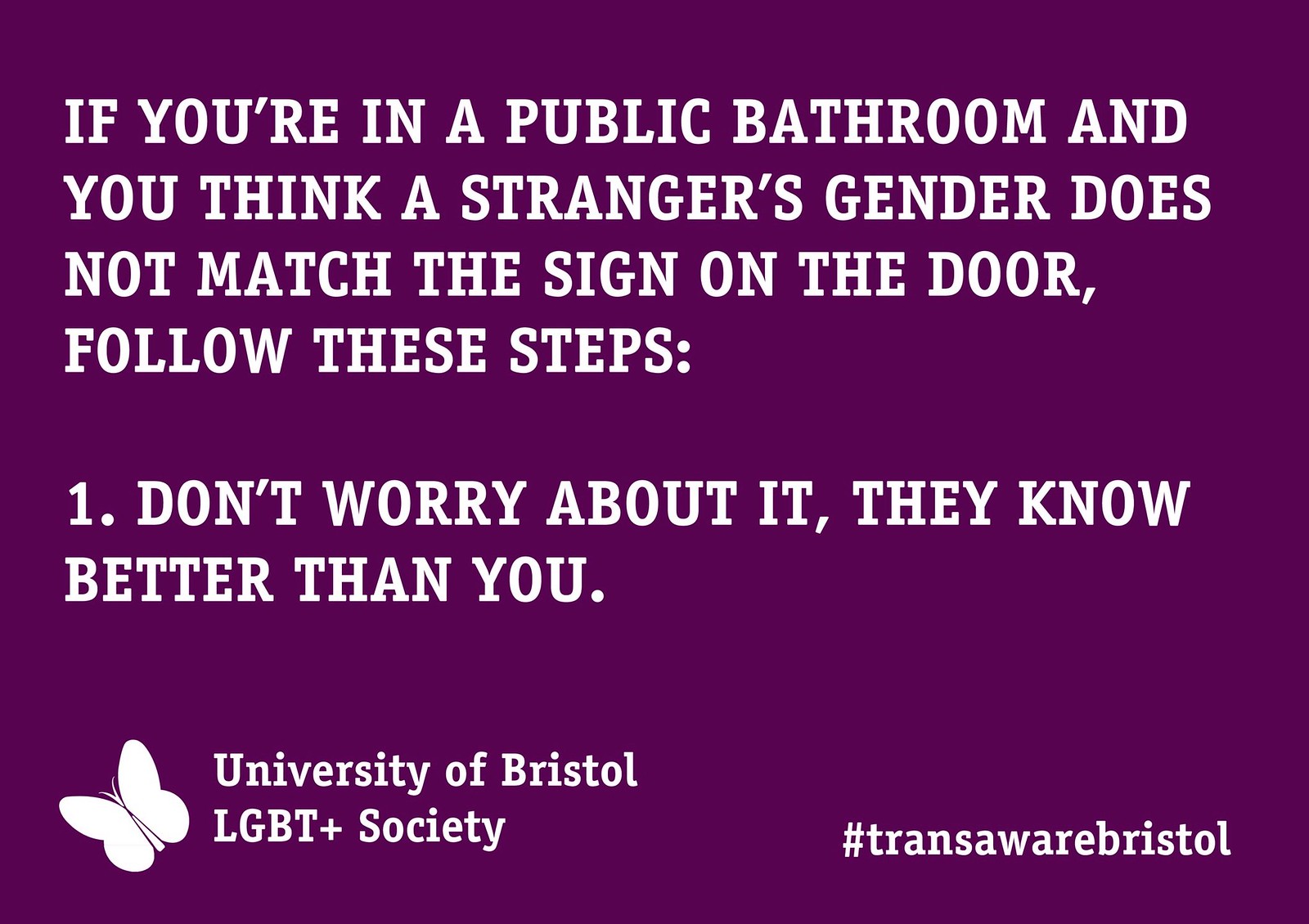This 48 page guide was written by the Transgender Law Center (@TransLawCenter) in 2005 (!) about the issue of bathrooms in public spaces.
Because our world famous Innovation Consultancy (@KPInnovation) and facilities team is getting together at our world famous Garfield Center (@KPGarfield), I’m going right to the solutions. They are as relevant today as they were 10 years ago, before there was hope that health care would listen.
Single-Stall Gender-Neutral Bathrooms
Gender-neutral bathrooms are a great way to dramatically increase people’s bathroom safety. If a bathroom is not divided into “men’s” and “women’s” facilities, nobody using that bathroom would go in with stereotypical expectations about who else should be in there or how they should look. This would really improve the whole bathroom experience for a lot of transgender folks.
After all, the single-stall bathrooms in our homes don’t have a “male” or “female” sign on them. So, gender-neutral single-stall bathrooms are not really very different from the bathrooms that we use in our homes.
And… this is the law in Washington, DC, although not yet in California (I’m always shocked when I see them there – tick,tock). Being ahead of things on this coast has shown this to be an effective, empowering, safety-supporting intervention. No reason not to do it.
Nearly 100 restaurants & businesses alerted so far. Keep them coming! #safebathroomsDC pic.twitter.com/IsJRuxPLIR
— DCOfficeHumanRights (@DCHumanRights) June 25, 2014
Multi-Stall Gender-Neutral Bathrooms
This is the new frontier in 2015, and actually, it’s not a frontier anymore for the most modern businesses. I have even posted a collection of images of multi-stall gender neutral bathrooms. We’ve temporarily turned the multi-stall bathrooms where I work into gender neutral bathrooms. With no ill effects.
If there’s a place to innovate in facilities, this is it.
As written in 2005, this is an innovation that’s less society-leading and stereotype shattering and more humane, common-sense, and probably money saving:
By eliminating the whole idea that one bathroom is for men and one is for women, we would be able to get rid of the stereotypical expectations that cause so much trouble. No one would feel like they were in the wrong bathroom or that they could make someone else feel unwelcome simply because that person did not look the right way. Parents could keep an eye on their children and people who need assistance using the bathroom would be able to get that assistance from any family member or attendant.
Most existing bathrooms would not need significant physical alterations. Urinals could be made more private by being placed inside a stall. And as new buildings are being constructed, the demand for gender-neutral bathrooms could also result in small changes to increase privacy. For instance, stall doors could be built taller and extend closer to the ground. Locks on stall doors could be made stronger and more functional.
Again, this is already being done here in Washington, DC, and in other places on the east coast. Not hard to find examples. See this series of photos I took of one such bathroom: Innovation, Respect, Safety, Beauty: Multistall gender neutral bathrooms at The Coupe DC
Gender-Neutral Bathrooms on Alternating Floors
In large buildings with a lot of multi-stall bathrooms, making the bathrooms on every other floor gender-neutral helps to create safety. It requires no new construction and no cost to business owners except the price of new signs.
The Why
There are tons of information online about the issue of safe bathrooms. This article quotes a rate of 50% of harassment or assault in a public bathroom (2002 study by San Francisco Human Rights Commmission). A more recent study by the Williams Institute quotes 18% denial of access to a gender segregated public-bathroom, 68% harrassment, 9% assault. Time Magazine did a nice review recently: Everything You Need to Know About the Debate Over Transgender People and Bathrooms | TIME
More data, tons of more data
There’s a very nice review of the history of building codes that show that the idea of gendered bathrooms in the first place is a historical accident: The Biggest Obstacle to Gender Neutral Bathrooms? Building Codes. – Reason.com.
This might help you if you are in the facilities design and building business. Let me know in the comments if it did help you so I might pass it on to others in your field.
The team from the iconic Fenway Institute (@FenwayHealth) just published a paper in Milbank Quarterly* Legal Protections in Public Settings: A Critical Public Health Issue for Transgender and Gender-Nonconforming People about the health impacts of discrimination in access to public accommodation. There are many.
*And it’s just impressive in 2015 to see publications from organizations like @MilbankFund covering this issue.
Here’s an image that may help.

And one with a little humor attached:

But really, this isn’t funny.
Safe bathroom access is not a luxury or a special right. Without safe access to public bathrooms, transgender people are denied full participation in public life.